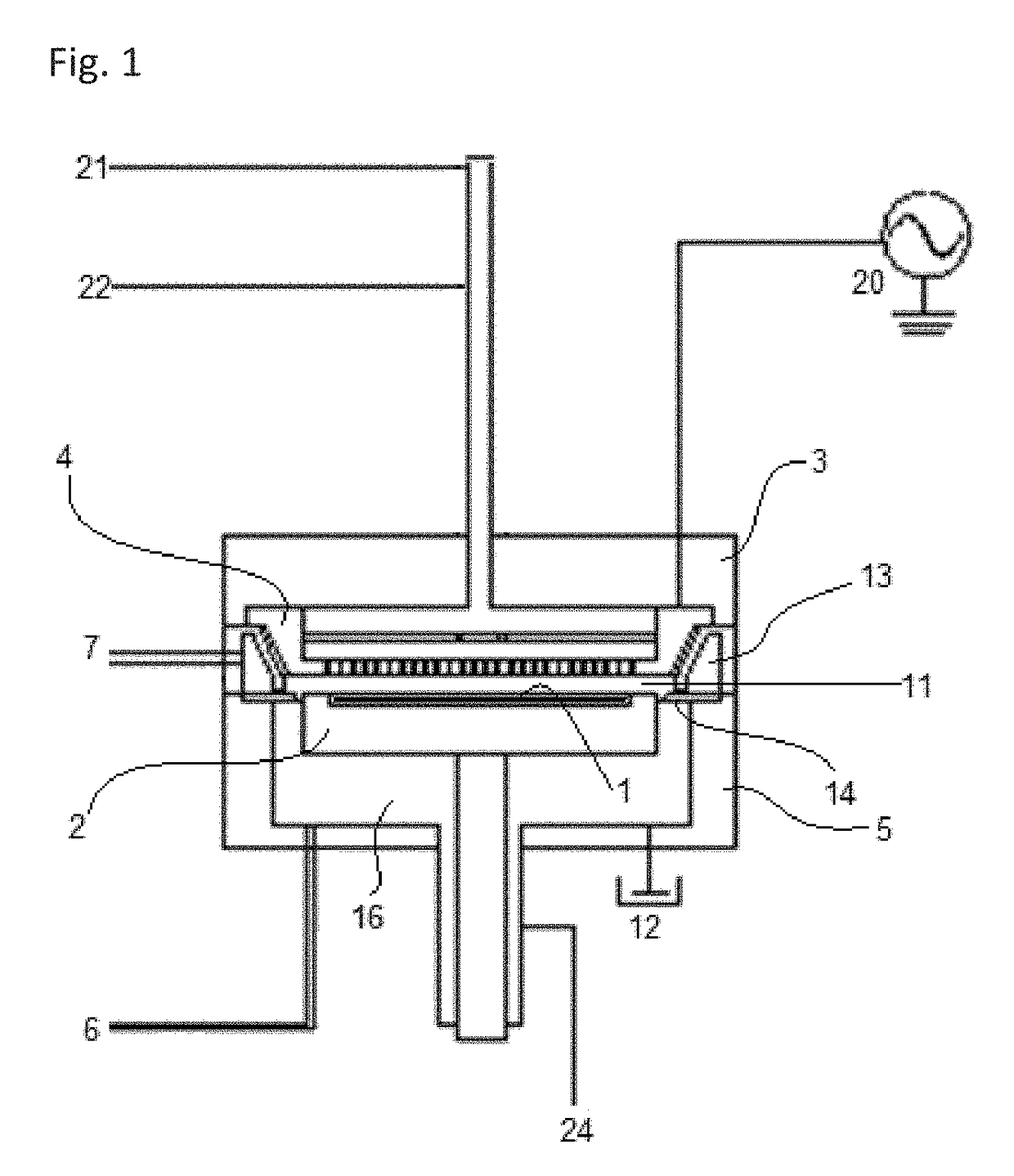Method of reforming insulating film deposited on substrate with recess pattern
a technology of insulating film and recess pattern, which is applied in the direction of basic electric elements, semiconductor/solid-state device manufacturing, electric devices, etc., can solve the problems of poor quality of the film deposited on the sidewall portion of the trench, etc., to improve the properties improve the quality of the sidewall portion, and low atomic weight
- Summary
- Abstract
- Description
- Claims
- Application Information
AI Technical Summary
Benefits of technology
Problems solved by technology
Method used
Image
Examples
example 1
[0061]A substrate (having a diameter of 100 mm and a thickness of 0.7 mm) having a SiO2 film deposited by PEALD was provided wherein the substrate had trenches with an opening width of approximately 30 nm and a depth of approximately 300 nm (an aspect ratio of 10). The SiO2 film was formed on an underlying layer (SiN) by PECVD with a thickness of about 15 nm on the substrate, which underlying layer was formed in order to adjust the shapes of the trenches before depositing the SiO2 film wherein the trenches of the substrate with the underlying film had an opening width of approximately 60 nm and a depth of approximately 300 nm (an aspect ratio of 5). Reforming treatment was conducted on the substrate using a sequence illustrated in FIG. 13 under the conditions shown in Table 2 below using the apparatus illustrated in FIG. 12, wherein the film was deposited using the apparatus illustrated in FIG. 1 which was hermetically connected to the apparatus for reforming process via a wafer han...
example 2
[0065]Substrates with insulating films (with an aspect ratio of 10) were provided as described in Example 1 and were reformed under the conditions used in Example 1 (a pressure of 1 Pa) except that the reforming gas was changed as shown in Table 4 below, to determine resistance to wet etching at the sidewalls of trenches.
TABLE 4(numbers are approximate)Reforming gasΔSide - Etched thickness (nm)Example 2H22Comp. Ex. 3N25Comp. Ex. 4O28Comp. Ex. 5Ar8
[0066]As shown in Table 4, when using H2 gas, the resistance to wet etching was significantly improved in Example 2, as compared with the use of N2 (Comparative Example 3), O2 (Comparative Example 4), and Ar (Comparative Example 5).
[0067]Further, in Example 2, the concentration of hydrogen atoms in the film before the reforming treatment was 7×1021 atms / cm3, and the concentration of hydrogen atoms in the film after the reforming treatment was reduced to 2×1021 atms / cm3 (which was determined using X-ray fluorescence analysis).
example 3
[0068]A substrate (having a diameter of 100 mm and a thickness of 0.7 mm) having a SiO2 film deposited by PEALD was provided wherein the substrate had trenches with a width of approximately 30 nm and a depth of approximately 300 nm (with an aspect ratio of 10). The SiO2 film was formed by PEALD with a thickness of about 7 nm on the substrate and a conformality of about 100%. Reforming treatment was conducted on the substrate using a sequence illustrated in FIG. 13 under the conditions shown in Table 5 below using the apparatus illustrated in FIG. 12. Multiple films were treated under partially different conditions of reforming treatment for analysis (see FIG. 8). The reformed film was subjected to wet etching (dipped in a solution of DHF 1000:1 for 10 minutes) and analyzed for resistance to wet etching. The results are shown in FIG. 8.
TABLE 5(numbers are approximate)Conditions for Reforming ProcessSubstrate temperatureNo heating (room temperature)Electrode gap80 mmPressure during st...
PUM
 Login to View More
Login to View More Abstract
Description
Claims
Application Information
 Login to View More
Login to View More - R&D
- Intellectual Property
- Life Sciences
- Materials
- Tech Scout
- Unparalleled Data Quality
- Higher Quality Content
- 60% Fewer Hallucinations
Browse by: Latest US Patents, China's latest patents, Technical Efficacy Thesaurus, Application Domain, Technology Topic, Popular Technical Reports.
© 2025 PatSnap. All rights reserved.Legal|Privacy policy|Modern Slavery Act Transparency Statement|Sitemap|About US| Contact US: help@patsnap.com



